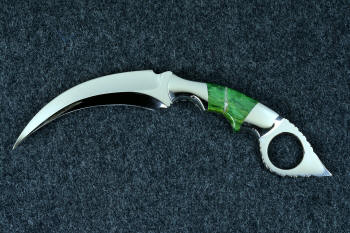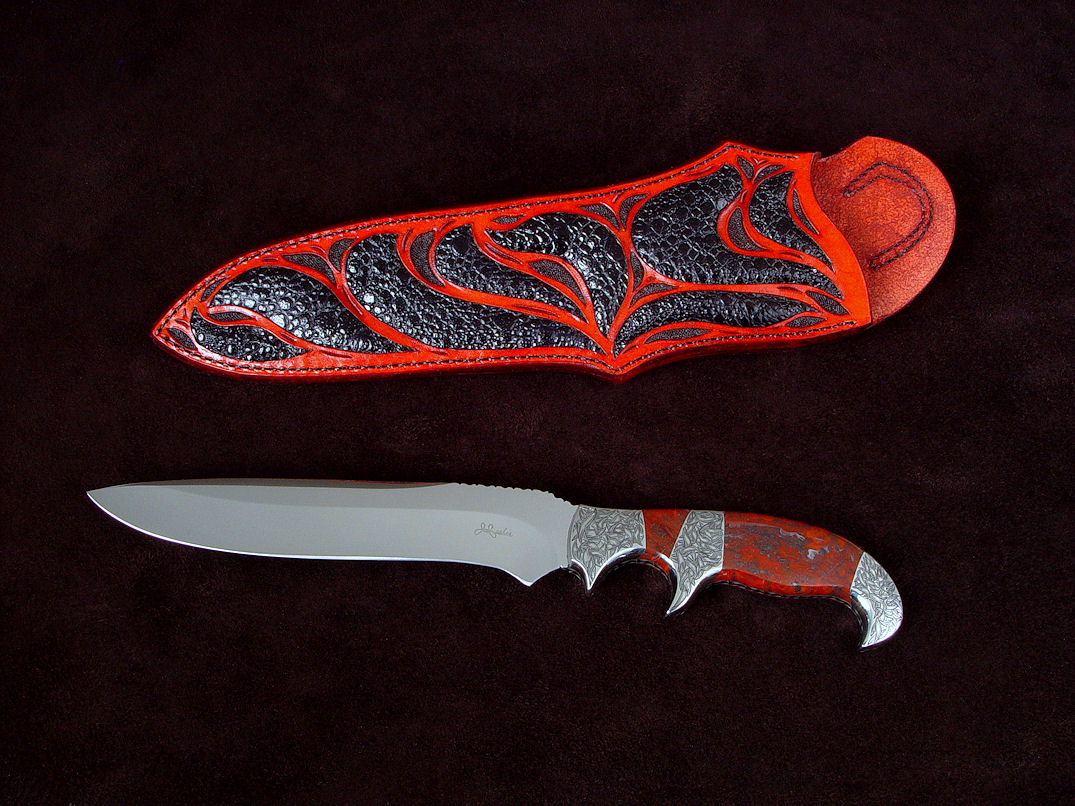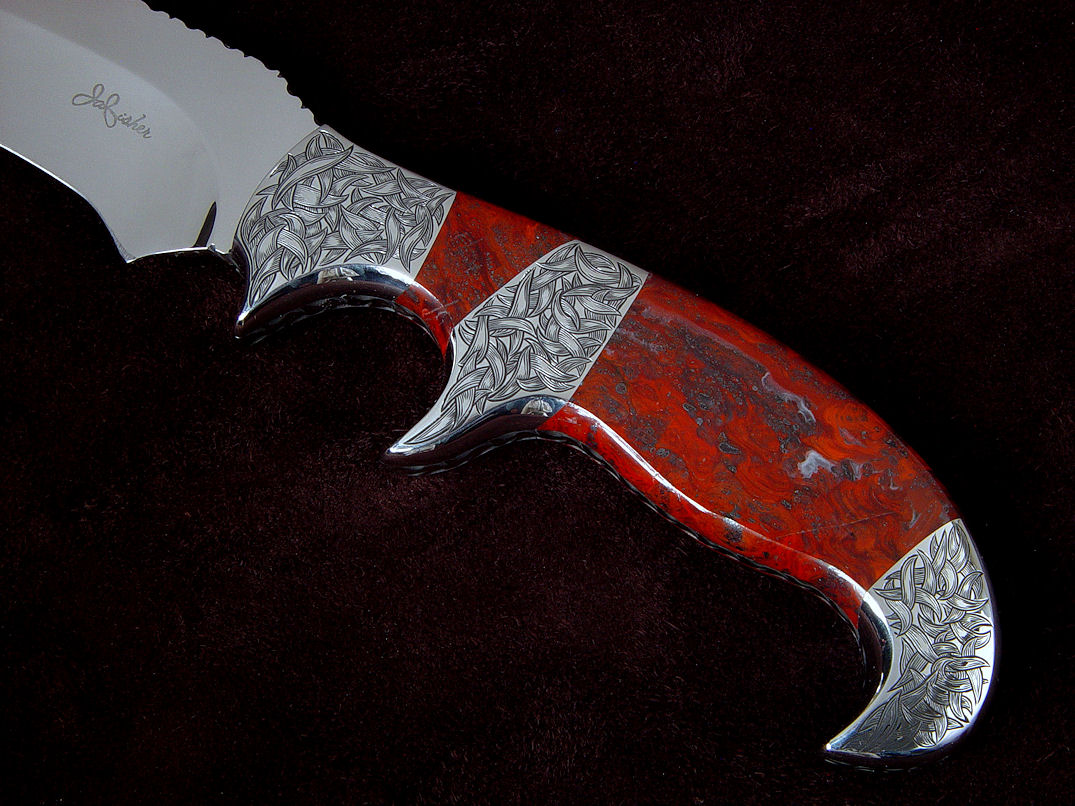Jay Fisher - Fine Custom Knives
New to the website? Start Here

"Raptor"


Thanks, G. L.!
The feel, balance, and natural ergonomic design of the Sargon handle is exceptional – more than any other knife I have ever previously held, it really feels like a natural extension of the hand, and is quite secure and comfortable to hold, as I’m sure it will be to use. The engraving on the bolsters is aesthetically appealing and perfect (at least to my eyes), but not so ornate as to detract from the other elements of the knife. And the fossilized stromatolite algae handle scales are as beautiful to behold, as they are to contemplate – timeless, in fact. To imagine the huge span of time witnessed by this exceptional material, and realize that our entire lifetimes, or indeed, the existence of mankind, occupy but a vanishingly small fraction of the time taken for it to form, and its subsequent persistence on earth, is a truly humbling realization.
As I have with the other works I acquired from you, I very much appreciate the exacting and detailed filework on the spine of this knife, as well as the edgework. Finally, the mirror polish of the blade, its mellifluous lines, and its exquisite sharpness combine to make it a treasure to behold, but also one of the finest, yet most fundamental of tools. (The unique combination of utility, and art, are, first and foremost, the qualities that piqued my interest in fine, handmade knives at the outset, as I am sure is the case for many knife aficionados).
As I had already mentioned in my earlier missive, I was extremely impressed by the thought and execution of the sheath you created for the Sargon. In my humble opinion, it represents one of the finest and most complex sheaths you’ve ever created (at least of those I am familiar with). Its construction and contrasts result in a sort of trompe l'oeil effect, so that it appears to me, not as a simple, flat surface, but a truly three-dimensional structure which, viewed under the correct conditions, “jumps out at the viewer.” The bold colors of the leather nicely complement the scale gemstone as well. (BTW, one observes some extremely interesting optical effects when illuminating the scales with a green (532 nm) or red (693 nm) laser at an acute angle – certain mineral elements apparently behave as optical conduits when thus illuminated. I will attempt to photograph the effect and forward the results to you later.)
Jay, I must apologize for the fact that my crude descriptions, coupled with my rather nascent knowledge and understanding of knife-making art and technology can neither adequately nor eloquently describe my appreciation of your creations. I am certain, that, with time, education, and observation, I will eventually become better enabled to do so on many more levels than I can currently. Fortunately, your extraordinarily detailed website provides all of the means required for such an education. (Moreover, I must have a better look at the knife under natural sunlight, instead of the grim artificial light I currently have available.)
--G. L.
| Main | Purchase | Tactical | Specific Types | Technical | More |
| Home Page | Where's My Knife, Jay? | Current Tactical Knives for Sale | The Awe of the Blade | Knife Patterns | My Photography |
| Website Overview | Current Knives for Sale | Tactical, Combat Knife Portal | Museum Pieces | Knife Pattern Alphabetic List | Photographic Services |
| My Mission | Current Tactical Knives for Sale | All Tactical, Combat Knives | Investment, Collector's Knives | Copyright and Knives | Photographic Images |
| The Finest Knives and You | Current Chef's Knives for Sale | Counterterrorism Knives | Daggers | Knife Anatomy | |
| Featured Knives: Page One | Pre-Order Knives in Progress | Professional, Military Commemoratives | Swords | Custom Knives | |
| Featured Knives: Page Two | USAF Pararescue Knives | Folding Knives | Modern Knifemaking Technology | My Writing | |
| Featured Knives: Page Three | My Knife Prices | USAF Pararescue "PJ- Light" | Chef's Knives | Factory vs. Handmade Knives | First Novel |
| Featured Knives: Older/Early | How To Order | 27th Air Force Special Operations | Food Safety, Kitchen, Chef's Knives | Six Distinctions of Fine Knives | Second Novel |
| Email Jay Fisher | Purchase Finished Knives | Khukris: Combat, Survival, Art | Hunting Knives | Knife Styles | Knife Book |
| Contact, Locate Jay Fisher | Order Custom Knives | Serrations | Working Knives | Jay's Internet Stats | |
| FAQs | Knife Sales Policy | Grip Styles, Hand Sizing | Khukris | The 3000th Term | Videos |
| Current, Recent Works, Events | Bank Transfers | Concealed Carry and Knives | Skeletonized Knives | Best Knife Information and Learning About Knives | |
| Client's News and Info | Custom Knife Design Fee | Military Knife Care | Serrations | Cities of the Knife | Links |
| Who Is Jay Fisher? | Delivery Times | The Best Combat Locking Sheath | Knife Sheaths | Knife Maker's Marks | |
| Testimonials, Letters and Emails | My Shipping Method | Knife Stands and Cases | How to Care for Custom Knives | Site Table of Contents | |
| Top 22 Reasons to Buy | Business of Knifemaking | Tactical Knife Sheath Accessories | Handles, Bolsters, Guards | Knife Making Instruction | |
| My Knifemaking History | Professional Knife Consultant | Loops, Plates, Straps | Knife Handles: Gemstone | Larger Monitors and Knife Photos | |
| What I Do And Don't Do | Belt Loop Extenders-UBLX, EXBLX | Gemstone Alphabetic List | New Materials | ||
| CD ROM Archive | Independent Lamp Accessory-LIMA | Knife Handles: Woods | Knife Shop/Studio, Page 1 | ||
| Publications, Publicity | Universal Main Lamp Holder-HULA | Knife Handles: Horn, Bone, Ivory | Knife Shop/Studio, Page 2 | ||
| My Curriculum Vitae | Sternum Harness | Knife Handles: Manmade Materials | |||
| Funny Letters and Emails, Pg. 1 | Blades and Steels | Sharpeners, Lanyards | Knife Embellishment | ||
| Funny Letters and Emails, Pg. 2 | Blades | Bags, Cases, Duffles, Gear | |||
| Funny Letters and Emails, Pg. 3 | Knife Blade Testing | Modular Sheath Systems | |||
| Funny Letters and Emails, Pg. 4 | 440C: A Love/Hate Affair | PSD Principle Security Detail Sheaths | |||
| Funny Letters and Emails, Pg. 5 | ATS-34: Chrome/Moly Tough | ||||
| Funny Letters and Emails, Pg. 6 | D2: Wear Resistance King | ||||
| Funny Letters and Emails, Pg. 7 | O1: Oil Hardened Blued Beauty | ||||
| The Curious Case of the "Sandia" |
Elasticity, Stiffness, Stress, and Strain in Knife Blades |
||||
| The Sword, the Veil, the Legend |
Heat Treating and Cryogenic Processing of Knife Blade Steels |